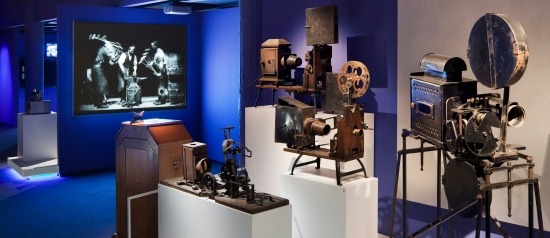
Projectors in Behind the Screen
EXHIBITION
Behind the Screen
Ongoing
As of October 1, the third floor of Behind the Screen, with its interactive experiences, has reopened.
The core exhibition of the Museum, Behind the Screen is a one-of-a-kind experience that immerses visitors in the creative and technical process of producing, promoting, and presenting films, television shows, and digital entertainment. Occupying 15,000 square feet of the Museum’s second and third floors, the exhibition reveals the skills, material resources, and artistic decisions that go into making moving images. Behind the Screen also introduces visitors to the history of the moving image, from nineteenth-century optical toys to the present-day impact of digital tools on film editing and post-production.
Artifacts: The exhibition incorporates approximately 1,400 artifacts from the Museum’s collection of the material culture of the moving image. These include historic film and television cameras, projectors, television sets, sound recording equipment, costumes, set design sketches and models, make-up, fan magazines, posters, and an outstanding collection of licensed merchandise—dolls, toys, board games, lunch boxes, and more. The Museum has also been a pioneer in collecting video arcade and console games, which are on exhibit and available for play by visitors.
Computer-based interactive experiences: Visitors may record their own movements as a sequence of still photographs that can be printed out and made into a flipbook; create their own stop-motion animations, which they can save and email; record their voices over dialogue from a film, following the same procedure that actors use when dubbing their lines in post-production; choose sound effects to add to the images of well-known movies and television shows; add music to scenes from movies, and to experience how music affects mood and tone.
Audio-visual material: Behind the Screen includes nearly four hours of audio-visual material that ranges from film clips related to the artifacts on display; projections of the earliest kinetoscope films, The Great Train Robbery, and selections from The Jazz Singer and Nanook of the North, all of which bring key moments in film history vividly to life; special videos, including The First Movies about Etienne Jules Marey and Chuck Workman’s Precious Images; and a simulation of a live TV control room, taking visitors inside the room where director Bill Webb called the shots for the broadcast of a game between the New York Mets and San Diego Padres.
Commissioned artworks: Artworks created especially for incorporation into Behind the Screen are Tut’s Fever by Red Grooms and Lysiane Luong, a real movie theater equipped for video that seats thirty-five; TV Lounge by Jim Isermann, an environment resembling a 1960s living room; and Feral Fount by Gregory Barsamian, a stroboscopic zoetrope using 97 sculptures rotating on an armature to create a short animation.

ADR interactive in Behind the Screen

Licensed merchandise in Behind the Screen

